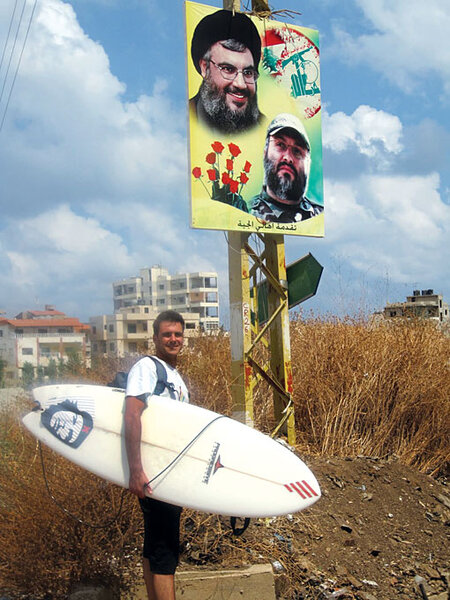Surfing the Blue Line between Israel and Hezbollah
Loading...
| Beirut, Lebanon
• A local, slice-of-life story from a Monitor correspondent.
Jesse Aizenstat says he is “surfing a détente – one wave at a time.”
Last summer, the California native embarked on a trip to Israel and Lebanon, chasing the region’s best waves and looking for new perspectives on the region’s conflicts.
“As a surfer, you’re always looking for new spots,” says Mr. Aizenstat. “I noticed that there was a question that both surfers in Lebanon and Israel had: What kind of coast is on the other side of the Blue Line?”
The Blue Line is the UN-demarcated line of Israel’s 2000 withdrawal from southern Lebanon. Despite travel restrictions, Aizenstat was determined to hear stories from surfers on both sides of the line, uniting them through a common interest across their political, cultural, and geographical divides.
“If I learned anything about coexistence, it’s that everyone in the region, at one point or another, has lived together,” says Aizenstat. “It’s only been the last 60 to 70 years that we’ve seen the demographics shift.”
Traveling with his custom-crafted surfboard in tow, Aizenstat received his share of strange looks navigating through Israeli Defense Forces checkpoints in the West Bank and hitching rides through Hezbollah-controlled areas of southern Lebanon.
While Israel has a developed surf scene, in Lebanon the majority of the country’s surfboards reside on the walls of themed restaurants as decoration.
In the northern Israeli city of Haifa, Aizenstat met a close-knit group of Israeli surfers – made up of both Arabs and Jews, some of whom have been friends since childhood – leading him to view surfing as a potential medium for mediation and understanding in the region.
“Most of the Palestinians and Jews in Haifa don’t mix,” he says. "But through surfing, people are, at the very least, civil – some even good friends, best friends” bound by the sea.
[Editor's note: The original photo caption misidentified Imad Mughniyeh as Khaled Mashal.]
IN PICTURES: Peru's Surfing Alpaca
Related:





